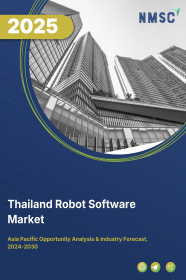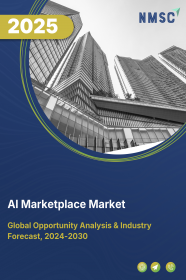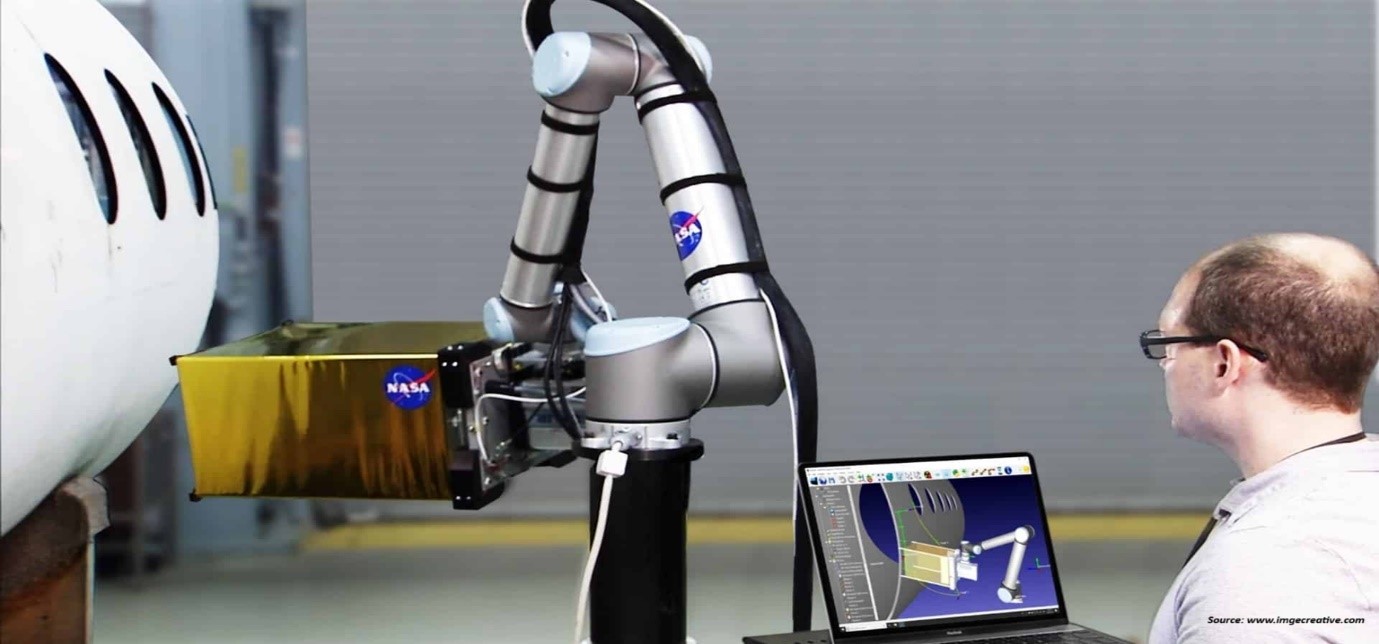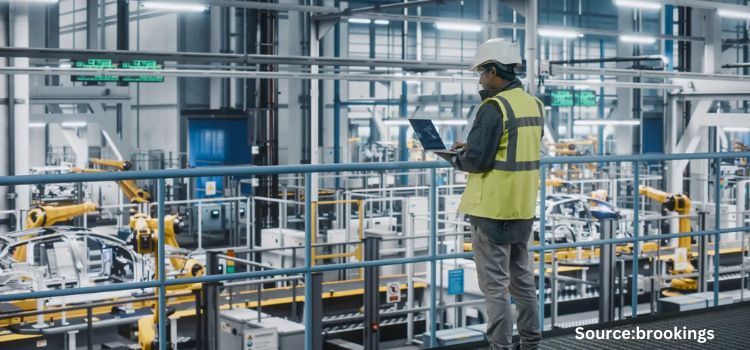
Thailand Robot Software Market by Software Type (Recognition Software, Simulation Software, Predictive Maintenance Software, Communication Management Software, and Data Management and Analysis Software), by Robot Type (Service Robots and Industrial Robots), by Deployment Mode (On-premise and On-demand), by Organization Size (Large Enterprises and Small and Medium-sized Enterprises (SMEs) – Opportunity Analysis and Industry Forecast, 2024–2030
Industry: ICT & Media | Publish Date: 14-Feb-2025 | No of Pages: 126 | No. of Tables: 92 | No. of Figures: 57 | Format: PDF | Report Code : IC2396
US Tariff Impact on Thailand Robot Software Market
Trump Tariffs Are Reshaping Global Business
Thailand Robot Software Market Overview
The Thailand Robot Software Market size was valued at USD 158.6 million in 2023, and is expected to reach USD 1037.9 million by 2030, with a CAGR of 29.6% from 2024 to 2030. Robot software constitutes a suite of programs and algorithms crafted to supervise and govern the operations of robots or robotic systems in diverse industries such as logistics, manufacturing, entertainment, healthcare, and more.
Its functionality encompasses several pivotal components. Firstly, it coordinates and manages the movements and behaviors of robots, ensuring precise and efficient task execution by issuing detailed commands to robotic components such as motors and actuators. Furthermore, robot software plays a critical role in interpreting data from various sensors embedded within robots, including cameras, Light Detection and Ranging (LIDAR) sensors, and tactile sensors. This data interpretation provides crucial environmental feedback that enables robots to accurately perceive and understand their surroundings.
An essential aspect of robot software is its ability to make intelligent decisions utilizing artificial intelligence (AI) and machine learning (ML) algorithms. Through the analysis of data from sensors, adherence to predefined rules, or learning from past experiences, robots can adapt to changing conditions, allowing them to operate autonomously and adjust their actions in real-time. Additionally, robot software facilitates communication and networking among robots, enabling collaboration for complex tasks or data exchange with a central control system. This interconnectedness facilitates synchronized operations in industrial environments, leading to enhanced efficiency and productivity.
The Convergence of Industry 4.0 and IoT Drive the Thailand Robot Software Market
The convergence of Industry 4.0 and the Internet of Things (IoT) acts as a significant driver propelling the growth of the Thailand robot software market. Industry 4.0, known for the integration of digital technologies into manufacturing processes, combined with advancements in IoT, has fundamentally transformed industrial automation.
IoT-enabled devices and sensors enable real-time data collection and communication, providing valuable insights into manufacturing operations and enhancing connectivity across the production ecosystem. This interconnected infrastructure creates opportunities for robot software solutions to leverage data analytics, predictive maintenance strategies, and adaptive control algorithms, thereby optimizing the performance and efficiency of robots.
Moreover, Industry 4.0 principles prioritize agility, flexibility, and scalability, fostering demand for robot software solutions that facilitate seamless integration, interoperability, and collaboration within smart manufacturing environments. Consequently, the synergies between Industry 4.0 and IoT fuel the adoption of robot software, driving innovation and efficiency in industrial automation processes.
Increasing Investments in Research and Development (R&D) Drive the Growth of the Thailand Robot Software Market
Increasing investments in research and development (R&D) are pivotal in propelling the growth of the robot software market in the country. With organizations and governments allocating more resources to R&D initiatives, there's a heightened emphasis on advancing robotics and automation technologies, including robot software.
These investments serve as catalysts for innovation, resulting in the development of more sophisticated and capable robot software solutions. R&D endeavors contribute significantly to enhancing functionalities such as AI integration, machine learning algorithms, and advanced control systems, thereby enabling robots to perform complex tasks with increased efficiency and autonomy.
Additionally, R&D investments facilitate the exploration of new applications and use cases for robot software across diverse industries, thereby expanding the market's potential. By fostering technological advancements and addressing emerging challenges, heightened R&D investments stimulate market growth and drive the evolution of the Thailand robot software market.
High Initial Investment for Acquiring Robot Hardware Restrain the Growth of the Thailand Market
The considerable upfront investment necessary for acquiring robot hardware acts as a significant barrier to Thailand robot software market growth in the country. Procuring robot hardware involves substantial initial costs, encompassing the purchase of robotic systems, peripherals, and associated equipment.
These expenses can be prohibitive for many organizations, particularly small and medium-sized enterprises (SMEs) or those with constrained budgets. The substantial financial commitment required for robot hardware might deter potential adopters from investing in robot software solutions, despite acknowledging their potential long-term benefits.
Additionally, the high initial investment may extend the return on investment (ROI) period, resulting in longer payback periods and limiting the scalability of robot deployments. Hence, addressing the challenge of high initial investment costs for robot hardware is crucial to facilitating broader adoption and driving Thailand robot software market growth.
The Expansion of Robotics-as-a-Service Creates New Opportunities in the Thailand Market
The expansion of Robotics-as-a-Service (RaaS) introduces fresh in the Thailand robot software market by providing a more accessible and cost-effective pathway for organizations to implement robotics solutions in the country. RaaS models enable businesses to access robotic hardware, software, and related services through subscription plans, eliminating the need for significant upfront investments in capital-intensive assets.
This approach reduces entry barriers, particularly for small and medium-sized enterprises (SMEs) or organizations with limited budgets, allowing them to leverage robotics technology without the financial constraints of ownership. Moreover, RaaS models often include maintenance, support, and software updates within the subscription, offering added value and simplifying the deployment process.
By democratizing access to robotics technology and promoting a pay-as-you-go model, the expansion of RaaS creates new Thailand robot software market opportunities, driving adoption across diverse industries and catalyzing innovation in robot software solutions.
Competitive Landscape
Several key players operating in the Thailand robot software industry include IBM, NVIDIA, ABB Ltd., FANUC, Teradyne, Inc., H2O.ai, Brain Corp, CloudMinds, Clearpath Robotics, and Neurala, Inc. These market players are adopting strategies to maintain their dominance in the market.
Thailand Robot Software Market Key Segments
By Software Type
-
Recognition Software
-
Simulation Software
-
Predictive Maintenance Software
-
Communication Management Software
-
Data Management and Analysis Software
By Robot Type
-
Service Robots
-
Ground
-
Aerial
-
Underwater
-
-
Industrial Robots
-
Traditional Industrial Robots
-
Articulated Robots
-
SCARA Robots
-
Parallel Robots
-
Cartesian Robots
-
Other Robots
-
-
Collaborative Industrial Robots
-
By Deployment Mode
-
On-premise
-
On-demand
By Organization Size
-
Large Enterprises
-
Small and Medium-sized Enterprises (SMEs)
By Industry Vertical
-
Banking, Financial Services, and Insurance (BFSI)
-
Automotive
-
Retail and eCommerce
-
Aerospace & Defense
-
Healthcare and Life Sciences
-
Transportation and Logistics
-
Manufacturing
-
Telecommunications and IT
-
Academia and Research
-
Media & Entertainment
-
Others
REPORT SCOPE AND SEGMENTATION:
|
Parameters |
Details |
|
Market Size in 2023 |
USD 158.6 Million |
|
Revenue Forecast in 2030 |
USD 1037.9 Million |
|
Growth Rate |
CAGR of 29.6% from 2024 to 2030 |
|
Analysis Period |
2023–2030 |
|
Base Year Considered |
2023 |
|
Forecast Period |
2024–2030 |
|
Market Size Estimation |
Million (USD) |
|
Growth Factors |
|
|
Companies Profiled |
10 |
|
Market Share |
Available for 10 companies |
|
Customization Scope |
Free customization (equivalent up to 80 working hours of analysts) after purchase. Addition or alteration to country, regional, and segment scope. |
|
Pricing and Purchase Options |
Avail customized purchase options to meet your exact research needs. |
KEY PLAYERS
-
IBM
-
NVIDIA
-
ABB Ltd.
-
FANUC
-
Teradyne, Inc.
-
H2O.ai
-
Brain Corp
-
CloudMinds
-
Clearpath Robotics
-
Neurala, Inc.

















 Speak to Our Analyst
Speak to Our Analyst





















